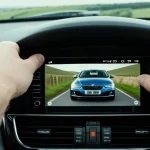Understanding Clutch Pedal Sensation and Free Play
Clutch pedal sensation is the tactile feedback a driver feels when pressing the clutch in a manual transmission vehicle. It plays a crucial role in the smooth operation of gear shifts, affecting driver confidence and vehicle control. A properly calibrated clutch pedal offers a predictable resistance and engages the transmission seamlessly.
The term clutch free play meaning refers to the small amount of movement the pedal has before the clutch actually begins to disengage. This free play is essential; without it, the clutch could remain partially engaged, causing premature wear or poor gear changes. Conversely, too much free play can lead to incomplete disengagement, resulting in gear grinding or difficulty shifting.
Additional reading : Boosting Airbag Efficiency in Minivans: Essential Strategies for Ultimate Safety and Protection
In manual transmission basics, understanding and maintaining correct free play is vital for the health of the clutch system. It ensures the clutch operates within design specifications, protects mechanical components, and provides the driver with consistent pedal feedback. When the free play is too tight or too loose, it disrupts the overall driving experience and can lead to costly repairs.
Accurately monitoring clutch pedal sensation and free play is the first step to maintaining optimal vehicle performance.
Also to see : Essential Insights into Vehicle Lowering: Uncovering the Safety Risks You Need to Know
Assessing the Need for Adjustment
Incorrect clutch free play can cause noticeable issues in vehicle operation. To start clutch diagnosis, recognize common symptoms of incorrect free play: a clutch pedal that feels too loose or too stiff, difficulty in shifting gears, or gear grinding when engaging. These signs indicate that the clutch may not be fully disengaging or engaging properly, risking damage to the transmission and clutch components.
Driving with improper free play affects both safety and the longevity of the clutch system. For example, excessive free play can prevent full clutch disengagement, causing jerky gear changes and accelerating wear. Conversely, too little free play might keep the clutch partially engaged, leading to overheating and slipping.
Manual vehicle maintenance routines should include regular checks of clutch pedal sensation and free play to detect these issues early. Addressing clutch free play adjustment promptly helps avoid costly repairs and ensures better control and smoother gear shifts. Seasonal inspections or when experiencing unusual clutch behavior are ideal times to perform a clutch diagnosis. Proper adjustment maintains the balance crucial for efficient clutch performance and driver confidence.
Safety Precautions and Tools Required
Before attempting any clutch pedal free play adjustment, observe key safety measures to prevent injury and avoid vehicle damage. Always work with the engine off and the vehicle securely parked on level ground with the parking brake engaged. Wearing gloves and safety glasses protects your hands and eyes during the process. Disconnecting the battery is also advisable to eliminate accidental electrical engagement.
A thoughtful vehicle inspection checklist ensures no overlooked hazards. Confirm no fluids are leaking near the pedal assembly and that the workspace is well-lit and clear of clutter.
Essential clutch adjustment tools include:
- A precise ruler or measuring tape to gauge free play accurately
- Wrenches or spanners matching your vehicle’s pedal assembly nuts
- Screwdrivers for accessing adjustment points
- A flashlight for visibility in tight spaces
Having these tools allows for a smooth and controlled clutch diagnosis and adjustment. Preparing properly addresses potential issues proactively and supports an efficient, safe manual transmission DIY experience. Remember, the right tools combined with proper safety measures protect both you and your vehicle during this maintenance task.
Step-by-Step Guide to Adjusting Clutch Pedal Free Play
Adjusting the clutch pedal free play is critical in manual transmission DIY projects for optimal clutch operation. Begin by locating the clutch pedal assembly—this is usually found under the dashboard, connecting the clutch pedal to the clutch cable or hydraulic system. Identifying the exact adjustment point is crucial and may involve removing a kick panel or inspecting linkage rods.
Next, measuring existing free play requires a ruler or measuring tape positioned at the pedal’s top. Push the pedal lightly until resistance begins, noting the free play distance. This measurement reflects the clutch free play meaning—the initial pedal movement before clutch disengagement. Accurate measurement ensures the adjustment’s effectiveness.
When making the adjustment, turn the clutch cable’s threaded adjuster or adjust the pushrod length to increase or decrease free play. Aim for the manufacturer-specified range, typically around 10-20mm of free play. After adjustment, re-measure to confirm. Accurate free play adjustment improves clutch pedal sensation, allowing smoother gear shifts and protecting transmission components.
Following these free play adjustment steps carefully supports clutch longevity and enhances overall driving experience in manual transmission basics.
Troubleshooting Common Issues After Adjustment
After performing clutch adjustment, it’s crucial to monitor clutch pedal feedback carefully. If you notice a spongy or overly stiff pedal feel, this may indicate a problem in the adjustment process or related components. Common clutch troubleshooting steps include rechecking the free play measurement to ensure it falls within the manufacturer’s specifications. Incorrect free play is often the root cause of inconsistent clutch engagement or difficulty shifting gears.
If trouble persists, inspect the clutch cable or hydraulic system for wear, damage, or fluid leaks, as these can affect pedal sensation. Sometimes cables stretch or hydraulics develop air bubbles, requiring bleeding. Also, verify that linkage connections are secure and not binding, which can create uneven pedal resistance.
To resolve adjustment problems, carefully repeat the free play adjustment steps, making smaller incremental changes and confirming measurements after each adjustment. Consistent clutch pedal sensation results from methodical troubleshooting and precise fine-tuning. Addressing these issues promptly prevents clutch slippage or engagement failures, preserving vehicle control and extending clutch lifespan. This ensures a reliable driving experience aligned with manual transmission basics.
Understanding Clutch Pedal Sensation and Free Play
Clutch pedal sensation refers to the driver’s tactile experience when pressing the clutch pedal, crucial for smooth gear changes in manual vehicles. It provides feedback on how the clutch engages and disengages, influencing driving precision and confidence. A well-tuned clutch pedal delivers a consistent resistance that signals correct operation.
The concept of clutch free play meaning is the slight pedal movement before the clutch starts to disengage. This free play ensures the clutch fully releases, preventing unwanted wear or gear engagement issues. When free play is too minimal, the clutch may remain partially engaged, causing slipping and overheating. Too much free play can delay clutch disengagement, leading to difficulty in shifting and grinding gears.
In manual transmission basics, proper clutch free play adjustment is vital for maintaining clutch health and vehicle control. It affects how effectively power transfers from the engine to the wheels and how the driver senses engagement points. Accurate free play measurement and adjustment optimize the clutch pedal sensation, ensuring smooth, safe driving and extending the lifespan of clutch components.








